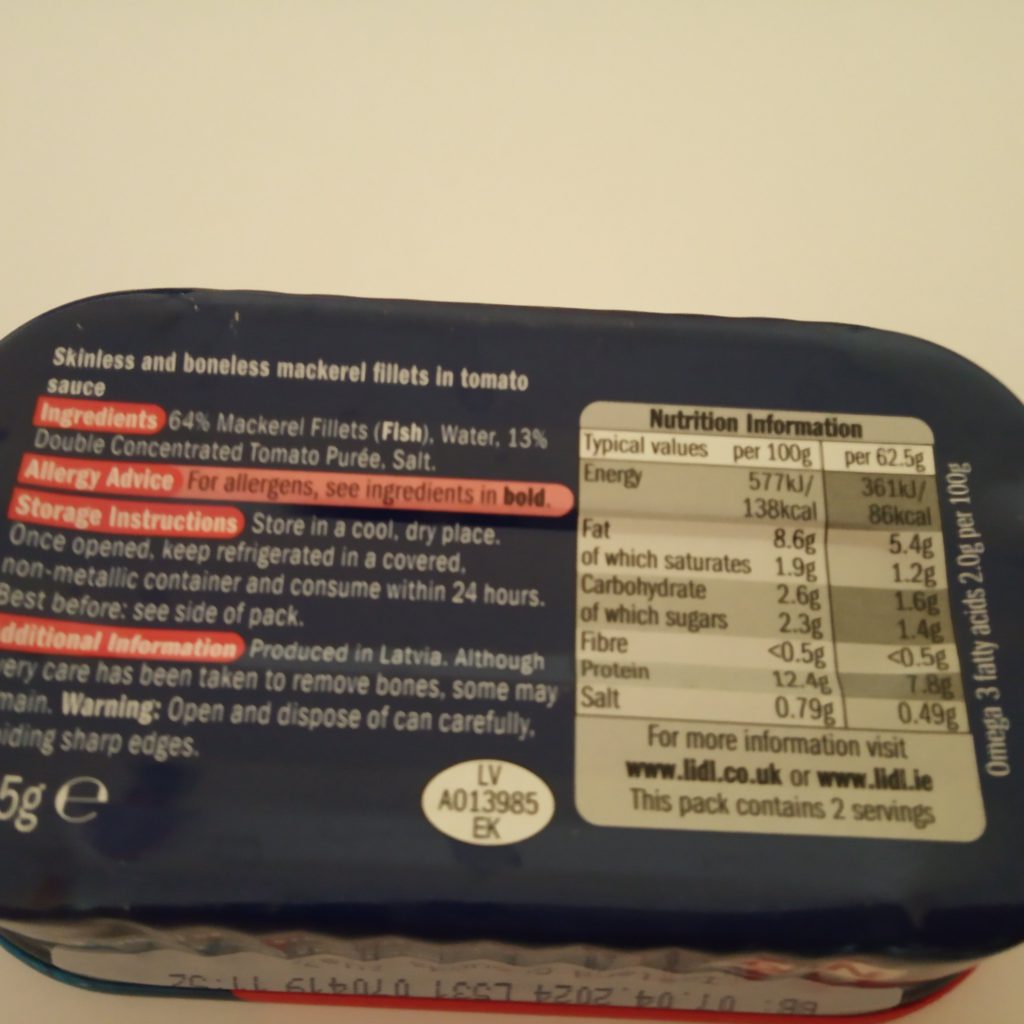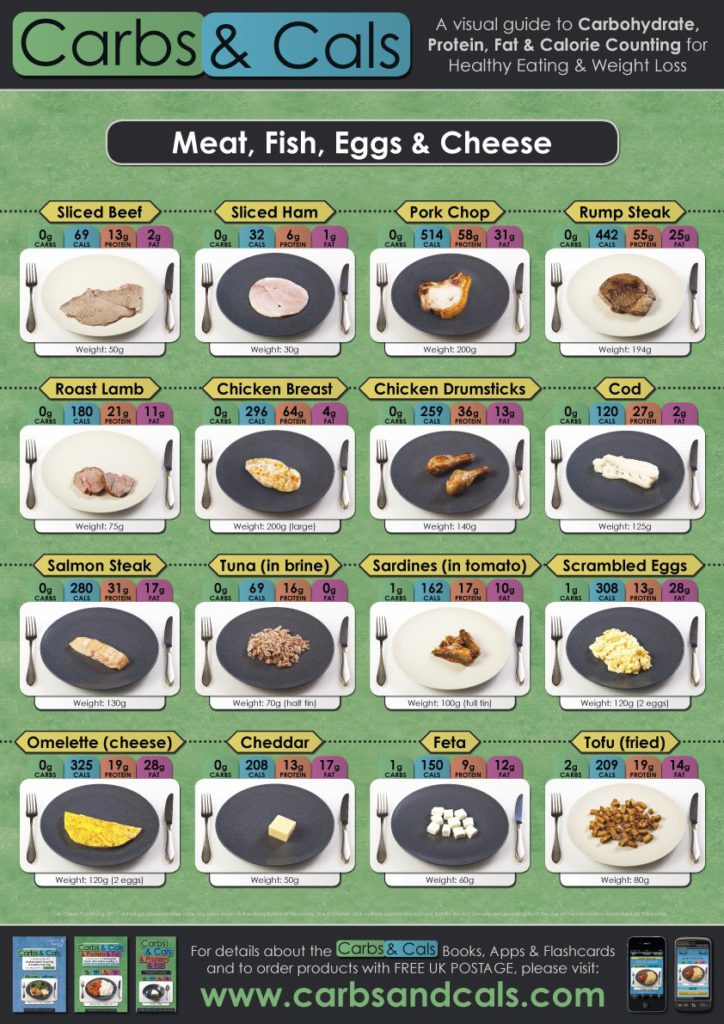http://Carbs & Cals: Count your Carbs & Calories with over 1,700 Food & Drink Photos!
Carbohydrate counting is counting the amount of carbohydrate there is in a meal.You can do an estmate by looking at your plate and judging how much carbohydrate there is on the plate.
Some foods have a higher carbohydrate content than others so the only way to truly measure carbohydrate content is to look at the food label.

Carbohydrate counting isn’t that difficult but can get messy when there are a number of nutrients in the meal.
When looking at the food label remember to discount salt from your carbohydrate count.
An Example Of A Carbohydrate Count
The Total of Carbohydrate can be calculated as follows:
The nutrient which has the lowest weight is Fibre which is less than 0.5g(Approximately 0.4g) which is equal to one unit of carbohydrate.
To get the number of units of carbohydrate for each of the other nutrients divide by the lowest nutrient weight.
For example in the case above for the mackerel tin in the picture you must divide by 0.4g.
The carbohydrate count for the carbohydrate in the mackerel is:
Add 2.6g and 2.3g which equals 4.9g divided by 0.4g equals 12 units.
One carbohydrate count is equal to 0.1 unit of insulin.
Therefore 12 units of carbohydrate count is equal to 1 unit of insulin.
If you have a food with no food label you weigh the food and divide the weight by 1 as there is only one nutrient so for example a potatoe which is 100% carbohydrate weighs for example 24g.
The carbohydrate count is 24units.
Therefore the number of units of insulin one would take would be 2 units.
For example if you have a meal and there is potatoes and their carbohydrate count is 24 units and you have a portion of mackerel and it’s carbohydrate count is 12 units and you have a portion of beans and its carbohydrate count is 22 units.
Therefore this meal has a total carbohydrate count of 58 units.
Therefore the number of units of insulin one would take would be 6 units.
Carbohydrate counting is a skill that can help you and your child plan his or her meals to manage diabetes and control blood sugar. Carbohydrate counting also can allow your child to eat a variety of foods, just like other kids, and to increase his or her confidence in managing diabetes.
When you and your child know how much carbohydrate is in food, you can spread it throughout the day and control portion sizes. This helps to keep your child’s blood sugar in his or her target range .Carbohydrates can cause high blood sugar which can make your child feel tired and thirsty and over time can damage many body organs and tissues.
Carbohydrate is the nutrient that makes blood sugar rise the most.
Foods that contain carbohydrate include:
Fruits and starchy vegetables (such as potatoes and corn).
Milk and yogurt.
Starchy foods (such as breads, cereals, rice, and pasta).
Sugary foods (such as candy and cakes).
Using carbohydrate counting method to provide consistent carbohydrate at each meal helps a child keep blood sugar at his or her target level.
You need to consult a registered dietitian or certified diabetes educator to help you and your child understand and use carbohydrate counting.
Following Meal Plans
Because healthy meals are so important, your diabetes health care team will probably give you a meal plan to follow. Meal plans don’t tell you exactly which foods to eat, but they might give you general information like which food groups to pick and when you should eat.
Your meal plan will include the foods that you already eat and like. The team will probably ask you to write down all the foods you eat in a food diary for a few days so that they know your tastes.
Your meal plan will help you think about healthy meals, but it also might help you reach other health goals. For example, if you need to lose weight, then the plan may suggest that you watch the number of calories and fat you eat to help you reach your goal.
Your parents or other grown-ups might make most of the meal-planning decisions. Two baked potatoes don’t make a balanced meal. But you could have half a baked potato along with some grilled chicken and some broccoli. Top it off with a dessert of fresh berries, and you have a great balanced meal.

My father-in-law is a great man for growing potatoes,he is a lovely quiet man who I respect and like a lot especially when he brings me a bucket of potatoes every Summer which he grows in his garden behind the house where him and Mary his wife live.
He loves his grandchildren very much and spends a lot of time with them.Their names are Rebecca and Laura.
Rebecca is a teenager now and Laura is still in primary school.They are two lovely girls whom I am very fond of especially since Laura is my Godchild,I was very happy when June my sister-in-law asked me to be Godmother for Laura’s christening.
Laura and Rebecca are very good at horseriding .They have both won medals for showjumping and love their two horses who are called Alex and Kiwi.
Bernard,my father-in-law is a very kind,generous man who is always giving Brendan my husband things for our garden such as flowers and shrubs.

He is a healthy man too for his age,he is active and agile and a pure gentleman like my husband!
He looks many years younger than his age,I think it must be all the fresh air and exercise he gets.
He has Type 2 diabetes but you would never think it by looking at him.He is slim and fit.
Carbohydrate Counting Meal Plan
With the carbohydrate counting meal plan, people with diabetes count carbs so they can match their insulin doses with the amount of carbohydrates that they eat. Counting carbs means the person counts the number of carbohydrate grams being eaten.
See the above picture of an example of carbohydrate counting for further information.
Step 1:Develop a meal plan
Develop a meal plan to get a good balance of carbohydrates, protein, and fat, and an appropriate amount of calories.
Step 2: Know your Carbohydrate
Most of the carbohydrates we eat come from three food groups: starch, fruit and milk. Vegetables also contain some carbohydrates for example potatoes, parsnips,peas and sweetcorn but foods in the meat and fat groups contain very little carbohydrates.
Each meal and snack will contain a total number of grams of carbohydrates It is more important to know your carbohydrate allowance for each meal and snack than it is to know your total for the day. The amount of carbohydrates eaten at each meal should remain consistent .
There is a resource available that can help you with carbohydrate counting see it listed below:
.http://Carbs & Cals & Protein & Fat Flashcards: 54 Flashcards for Counting Carbohydrate, Calories, Protein, Fat & Fibre by Chris Cheyette, Yello Balolia (2013) Cards
The best type of diet for diabetics is a plant based diet which has a lower amount of carbohydrate content than other processed unhealthy diets.
For further information see the following article on the importance of a plant based diet for diabetics.
See below for a picture of carbohydrate counting meal plans for different types of other healthy diets.
Food labels can tell you how many grams of carbohydrate are in a food. Knowing that, a person then matches the insulin dose with the amount of carbohydrates that he or she eats. This plan works best for people who take insulin (as a shot or with an insulin pump) with each meal.
How Food Labels Can Help
Food labels are easy to read, and they list a food’s ingredients, nutritional information, and calories. So anyone concerned about eating healthy can learn a lot from them. For people with diabetes, food labels provide information they need to know to keep their blood sugar on track.
For example, if you are using the carbohydrate counting meal plan, you can look for carbohydrates on the food label. It will tell you how many grams of carbs you are about to eat. The number of carbohydrate grams on the label applies to one serving, so be sure to multiply that number times the number of servings you’re eating or drinking.
If you’re using the carb counting plan, knowing the amount of carbs you’ve eaten can help you determine how much insulin to take.
Food labels also show you how much sodium (salt) is in a food. This is important because some people who have diabetes also have high blood pressure. Too much salt, or sodium, can worsen blood pressure problems.Remember salt is not a nutrient so dont include it in the carbohydrate count.
On food labels, you’ll also find information on the amount of fat, the type of fat, and the total calories in a food. It’s a good idea for everyone, including people who have diabetes, to keep an eye on these.
Eating too much of certain fats can make someone more likely to have heart and blood vessel problems. And eating too many calories can cause weight gain. Your parent, doctor, or nutritionist can help you figure out how many calories you need each day.
Write it Down
As you’ve probably noticed, meal plans mean a lot of keeping track especially the amount carbohydrate you’ve eaten. To make that easier, you might want to write down what you eat and your blood sugar readings on a record sheet.
Your mom or dad can use this record to help you balance food and insulin so you stay on track.
If you have any information,questions, or feedback you would like to include in this webpage.
Please email momo19@diabetessupportsite.com or leave your comments below.



